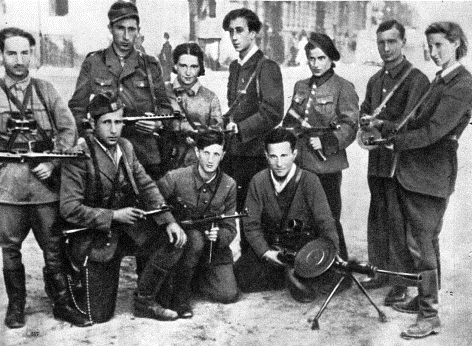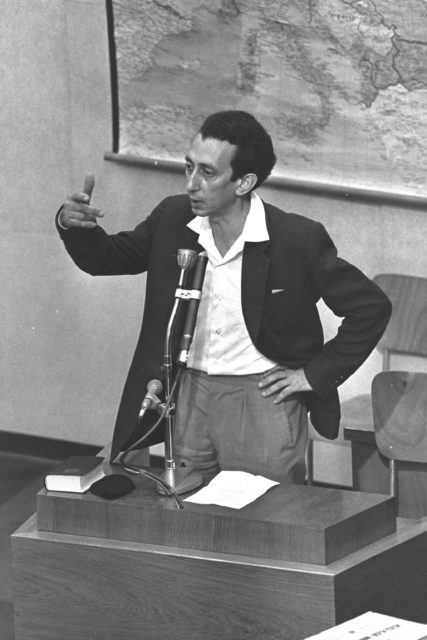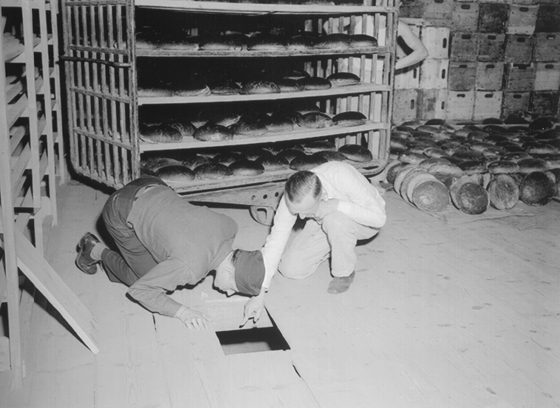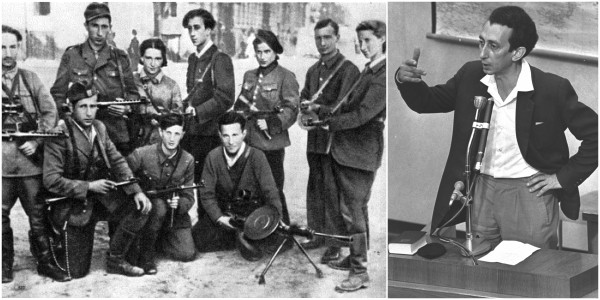The brutalities of the Holocaust became widely known in the aftermath of WWII. But many Jews felt that the Nuremberg trials did not bring about justice. Some decided to act on their own.
When in June 1941 Nazi Germany attacked the Lithuanian town of Vilnius, they set up a ghetto for the Jewish population. Besides being the site of oppression, the Vilna Ghetto became a place of resistance. Local youth, inspired and led by a poet, Abba Kovner, spread propaganda and soon established the Fareynikte Partizaner Organizatsye, or United Partisan Organization.
This self-defense organization took on a motto – ascribed to Kovner – that would become popular for generations and various different struggles to come: “We will not allow them to take us like sheep to the slaughter.” At that time, only a small part of the community actually believed that the Nazis were planning to eradicate the Jews. FPO’s call to action didn’t convince many to join their ranks, and they ended up fighting the Nazis from the woods, eventually joining the Soviet Army’s forces.

After the liberation, news of the extent of the Holocaust sent shockwaves throughout the world. Six million Jews had been exterminated. Nevertheless, a huge majority of the perpetrators managed to evade justice. The famous Nuremberg trials sentenced only 24 top Nazi commanders. The Allied forces identified 13.2 million Western Germans eligible for immediate prosecution. Out of that number, only 3.5 were actually charged, while only a million ended up being convicted of having anything to do with this horrific project. Their sentence: usually expropriation of looted Jewish assets and temporary employment restriction. Four years after the war has ended, only 300 found themselves behind the bars in Western Germany.
The international Jewish community was appalled, but their leaders were focused on trying to set up a state of their own in Palestine, while the victorious Western powers had their mind on the Cold War. The world was moving on. A group of resentful Holocaust survivors and partisan fighters was determined not to let it be. The Nazis had to pay.
With his prophecy vindicated by the tragic events, Abba Kovner gathered some of the surviving FPO fighters and veterans of the Jewish brigade (from British Palestine) to form the Nokmim or the Avengers. The group was also known as Nakam, their slogan being: “Dam Yehudi Nakam – Jewish Blood Will Be Avenged”.
The group initially set out on a meticulous anti-Nazi hunt, at first in Western Germany, but also Spain, Latin America, and Canada. They would hunt down ex-Nazi criminals and deal with them, usually making it look like a suicide by hanging. Some were to be found in roadside ditches, others died in car accidents caused by enigmatic mechanical failures. The secretive codex of the organization means that little is still known about the way they operated, but the number of their unsuspecting victims is thought to be close to several dozens.

Their modest human capacities and secretive strategy of illegality craved for a different approach if they were to really set the record straight. Thus, very early on they resorted to the old Biblical impeachment – an eye for an eye. Late in 1945, the group devised two plans.
Plan A consisted of poisoning the water supplies of Munich, Berlin, Weimar, Nuremberg, and Hamburg. The group infiltrated the water companies and spent some time working out how not to poison the local American-settled neighborhoods. At the same time, they sent out a delegation to Palestine in order to acquire the poison and support from the Jewish elders. It is speculated if and what kind of support they received, and whether they revealed their true plan. Some ex-members later claimed that it was the future first president of Israel, Chaim Weizmann, who put them in touch with the biophysicist who made the poison. His name was Ephraim Katzir, who in 1973 became the fourth president of Israel.
Nevertheless, some of the elders were completely opposed to such actions, probably informed by the fear that they would undermine the creation of Israel. Thus, the British military police arrested Kovner while on a boat back to Western Germany. His comrades threw away the bottles of poison into the Mediterranean.
Enter Plan B. The group discovered that a Nuremberg POW camp run by the Americans acquired its daily deliveries of bread from just one bakery. So, one of the group members got himself employed in the bakery as a trainee. One Saturday, him and three other of his comrades used a paint brush to poison 3,000 loafs of bread. On 20 April, news broke out: almost 2,000 German POWs were poisoned by arsenic. The exact number of fatalities was never published. Some speculate it is close to 300, others claim the number is much smaller.

Nakam’s activities slowly faded away into the 50s. Abba Kovner and his comrades obeyed their elders and left it to the new state of Israel and its forces to seek the retaliation. Kovner later became the most popular national poet of the new Jewish state. Others mostly joined the IDF. Only two ex-Nakam activists were threatened to be put on trial for the Nuremberg poisoning, but in 2000 the public prosecutor’s office stopped the preliminary investigation. In the end, the post-WWII world moved on.
